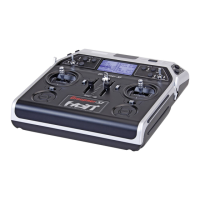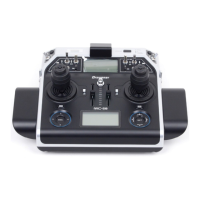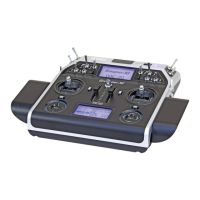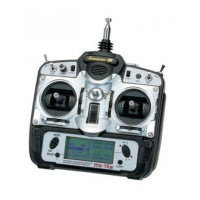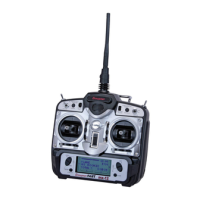240
Program description - Telemetry
TRIM (trim position)
In the “TRIM” line” you can carry out the fine adjust-
ment of the neutral position of a servo connected to
the control channel selected in the “OUTPUT CH” line
using the selection keys of the right four-way button
in 1 μs increments. The value in the “Centre” line can
be adjusted by the TRIM value set here in a range of
± 120 µs.
Factory setting: 0 μs.
LIMIT–/+ (side dependent travel limit –/+)
This option is provided for the adjustment of a side-de-
pendent limit (limiting) of the servo travel (rudder throw)
of the servo connected to the control channel selected
in the “OUTPUT CH” line.
The settings for both directions are separate but both
are in a range of 30 … 150 %.
Factory setting: 150 % each.
PERIOD (cycle time)
In this line you determine the time interval of the indi-
vidual channel impulse. This setting is adopted for all
control channels.
With the use of only digital servos, a cycle time of
10 ms can be set.
In mixed operation or with use of only analog servos,
20 ms should absolutely be set, because the latter can
otherwise be “over-strained” and react with “shaking”
or “quivering” as a result.
RX FAIL SAFE
RX FAIL SAFE V3.78
INPUT CH: 01
MODE : HOLD
F.S.POS. : 1500µsec
DELAY : 0.75sec
OUTPUT CH: 01
FAIL SAFE ALL: NO
POSITION : 1500µsec
The description of this menus necessitates a few words
of warning in advance:
“Do nothing” is the absolute worst thing to be
done in this regard. “HOLD” is prescribed in
the base setup model of the HoTT receiver.
In the event of a failure, in the best case scenario the
model ies straight ahead for an indenite amount of
time and then hopefully “lands” somewhere without
causing signicant damage! However, if something
like this happens in the wrong place at the wrong
time, the model may become uncontrollable and
“tear” across the ight eld completely out of control,
putting the pilot and spectators at risk.
Therefore, it would obviously be benecial to program
the the function “Motor off” at the very least, in order
to prevent such risks. If necessary, seek the advice of
an experienced pilot in order to nd a “logical” setting
for your model.
And then another brief notice regarding the three possi-
ble versions of the
mc-16 HoTT and mc-20 HoTT
transmitters for the setting of Fail Safe:
The easiest, and recommended, way to fail-safe set-
tings is the use of the »Fail Safe« menu, which can be
reached from the multifunction menu, see page 216.
Similarly, in order to achieve the same result somewhat
more laboriously, the “FAIL SAFE ALL” option de-
scribed on the following pages is also available.
In addition, there are the relatively elaborate methods
of the individual adjustment using the options “MODE”,
“F.S.Pos.” and “DELAY”. The description of these vari-
ants begins with the “MODE” option further below.
Value Explanation Possible
settings
OUTPUT
CH
Output channel
(servo connection of
the receiver)
1 … depending on
receiver
INPUT CH Input channel
(channel coming
from the transmitter)
1 … max. 12
MODE Fail-Safe mode HOLD
FAIL SAFE
OFF
F.S.POS. Fail-safe position 1000 … 2000 µs
DELAY Reaction time
(delay)
0.25, 0.50, 0.75
and 1.00 s
FAIL SAFE
ALL
Save of the Fail-
safe positions of all
control channels
NO / SAVE
POSITION Display of the saved
Fail-safe position
Between approx
1000 and 2000 µs
OUTPUT CH (servo connection)
In this line you select the respective OUTPUT CH (servo
connection of the receiver) to be set.
INPUT CH (selection of the input channel)
As already mentioned on page 236, the eight control
functions of the
mc-16 HoTT transmitter and the
mc-20 HoTT transmitter can be arbitrarily distribut-
ed to multiple receivers, if necessary, or even assigned
to multiple receiver outputs with the same control func-
tion.

